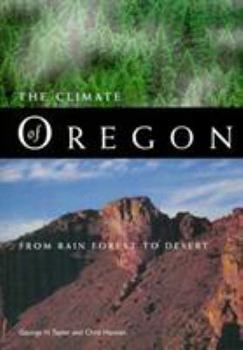The Climate of Oregon: From Rain Forest to Desert
No Synopsis Available.
Format:Paperback
Language:English
ISBN:0870714686
ISBN13:9780870714689
Release Date:September 1999
Publisher:Oregon State University Press
Length:224 Pages
Weight:1.05 lbs.
Dimensions:0.6" x 7.0" x 10.0"
Related Subjects
NatureCustomer Reviews
3 ratings
The Climate of Oregon: From Rain Forest to Desert
Published by Thriftbooks.com User , 16 years ago
No one understands the weather in Oregon better than George Taylor. This book is full of facts and interesting information. I would hope that it is used as a textbook in classes throughout the state and beyond. It's an interesting and informational read. I highly recommend it!
A good overview of the Oregon climate
Published by Thriftbooks.com User , 21 years ago
This book is the companion to Taylor's book "The Oregon Weather Book." Basically, "weather" refers to conditions at any given time, while "climate" refers to typical conditions based on averages over long periods of time. This, then, is a look at the average weather conditions in various parts of the state at different times of the year.Most people will be interested in the first three sections of the book, which provide a broad view of the climate elements in the state (precipitation, temperature, winds, humidity, cloud cover, snow, etc), the large-scale factors that influence them, and the specific conditions in nine distinct "climate zones" within the state. This information is provided through relatively sparse text and a LOT of tables, charts, and maps. The pages and pages of data may seem overwhelming at first, but the information of interest to the layman is easily located and understood. If you are planning a move to, say, Eugene, it is easy enough to look up typical conditions there month to month. With hardly more effort you can also gain a very basic understanding of why the climate in that area is as it is.The zone-by-zone descriptions also include a listing of the principal agricultural activities in that zone, which really fleshes out the bare numbers--knowing whether someplace is cattle, wheat, or wine country tells you a lot more than rainfall totals alone. Rainfall totals are there, though, month-by-month for dozens of weather stations. So are mean temperatures, frost dates, and growing seasons.If you have a deeper interest in climatology, the second half of the book includes information on how climate information is measured and reported, long-term climate trends and their effect on salmon, El Nino events, and global climate change.However, the book is not without its flaws. As someone who knows very little about weather and climatology, I didn't understand everything I read (not a huge problem, because the information that was most important to me was clear). The worst problem was that the maps were terrible. The core of the book is the influence of terrain features such as mountains and rivers on the climate, yet no map SHOWED any rivers or mountains. Reference is frequently made to different counties, yet there is no county map (the counties are shown but not labelled). The map showing all the climate zones has no cities or ANY reference points listed. Same with all the map-graphs of rainfall and temperature. How frustrating for outsiders trying to use the book to get to know Oregon! (For that matter, how many long term residents know all the state's counties?).The book was ultimately informative and interesting, if sometimes frustrating, so I do recommend it. But you'll probably glean the most from it if you already know something about Oregon and/or climatology.
Oregon Climate
Published by Thriftbooks.com User , 23 years ago
We used the book to determine which area to retire in Oregon. The book was very helpful for this purpose. It provided most of the information we needed to make a sound decision. It is well written with many good maps of the state.






